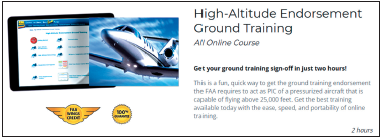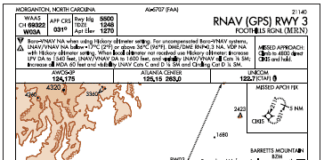Last year I got my multi-engine rating as I consider transitioning to a pressured twin. One of my instructors reminded me that I’d need a high-altitude endorsement to fly something capable of topping 25,000 feet. I probably read that somewhere, but it didn’t register. It’s true—I need the endorsement so I went about getting it.
Per § 61.31(g)(1) the endorsement requires both ground and flight training. I needed the ground training; I’d get the flight training as I got some time in type.
Options
A quick web search revealed that Flight Safety offers its High Altitude ground training as a “Live learning” online seminar led by a live instructor in 2.5 hours. Since it is a live course, you must be available at the specific time, which in the era of online learning is a bit restrictive. The cost is $355.
SIMCOM offers a four-hour classroom and simulator course to meet the ground training requirements. But you have to attend their training center in Orlando or Scottsdale. The cost is $1190. Or you might find a training facility that offers both the ground and flight training in your selected aircraft.
Self study is an option, but § 61.31(g)(1) requires that you have “received and logged ground training from an authorized instructor and obtained an endorsement … from an authorized instructor.” So you could teach yourself but you still gotta work with an instructor.
Of course, there’s the venerable King School, which claims to have trained half of all pilots. (I’m in that half.) Their on-line High Altitude Endorsement Ground Training course costs a reasonable $249. Completion time is estimated at two hours but you can do it at your leisure. I slid it in on a work day between Zoom meetings. The only technical requirement is an internet connection.
King It Is
To learn more, you can download the syllabus from the King web site. It lays out the course work in seven well-organized “Labs” with two to seven lessons in each. Each lesson is followed by a quiz. There are approximately 65 questions in the course and all questions must be correctly answered to obtain the certificate of completion that’s the FAA-required training record for your logbook.
Create a login or use your existing account and enter the key you got from the purchase. Click on the course title and you see the syllabus outline and links to print bonus course materials and your endorsement. Of course the latter won’t work until you finish.
Unlike the more complex King programmed learning courses, this course is exclusively text-based, with the odd graphic or image thrown in. The text is clear and concise, but you might unsuccessfully anticipate the “fun” mentioned in the course page. Fun or not, the material is all there and logically presented.
The course covers all the required topics; High Altitude Aerodynamics and Meteorology, Respiration and Hypoxia, Supplemental Oxygen and Pressurization, FAA Oxygen Regulations, and Airspace, Equipment, and Flight planning. As a glider pilot, the information on oxygen was well-traveled territory for me, but it was fun to imagine flying something with a mach meter or visiting the coffin corner.
My experience using my smallish cell phone to complete the Airspace lesson in the final lab was a little challenging. The course doesn’t seem to be mobile aware, so it needed zooming and scrolling—not exactly pretty, but doable in a pinch.
Ding Ding!
When you answer questions you’ll be treated to the familiar King double ding for a correct answer and a dong for a flub. After many King courses my reaction to these sounds is Pavlovian—I expect a treat with the double ding and cower after a dong.
When finished, you can print a completion certificate and your logbook endorsement. Here I ran into the only glitch in the course. When I got my commercial certificate I changed my certificate number from my social to an FAA-assigned number. I still had my old number in my King profile and that appeared on the logbook endorsement. Fixing this required the inevitable call to tech support.
All in all, this is a straightforward way to get the ground school endorsement without bothering your long-suffering flight instructor. She’ll probably thank you … at least until it’s time for the high-altitude flight training.
Bill Dolson read in the 1990s that a pressurized cabin-class twin was a good step-up from a complex single. He’s still going with that idea despite discouragement from insurance underwriters.





